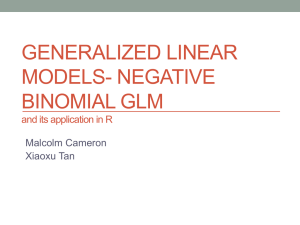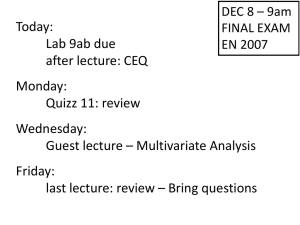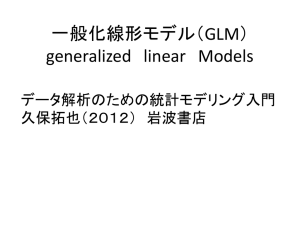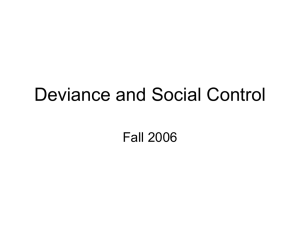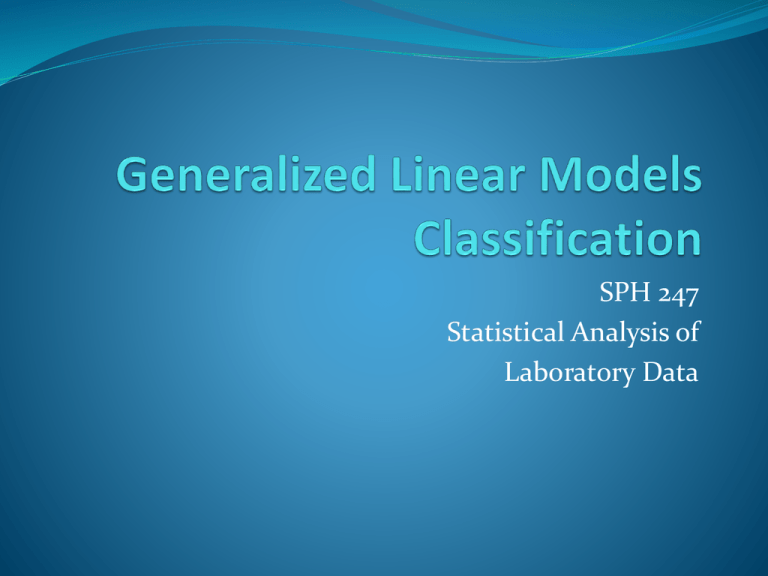
SPH 247
Statistical Analysis of
Laboratory Data
Generalized Linear Models
The type of predictive model one uses depends on a
number of issues; one is the type of response.
Measured values such as quantity of a protein, age,
weight usually can be handled in an ordinary linear
regression model, possibly after a log transformation.
Patient survival, which may be censored, calls for a
different method (survival analysis, Cox regression).
May 21, 2013
If the response is binary, then can we use logistic
regression models
If the response is a count, we can use Poisson
regression
If the count has a higher variance than is consistent
with the Poisson, we can use a negative binomial
Other forms of response can generate other types of
generalized linear models
May 21, 2013
Generalized Linear Models
We need a linear predictor of the same form as in linear
regression βx
In theory, such a linear predictor can generate any type of
number as a prediction, positive, negative, or zero
We choose a suitable distribution for the type of data we
are predicting (normal for any number, gamma for positive
numbers, binomial for binary responses, Poisson for
counts)
We create a link function which maps the mean of the
distribution onto the set of all possible linear prediction
results, which is the whole real line (-∞, ∞).
The inverse of the link function takes the linear predictor
to the actual prediction
May 21, 2013
Ordinary linear regression has identity link (no
transformation by the link function) and uses the
normal distribution
If one is predicting an inherently positive quantity, one
may want to use the log link since ex is always positive.
An alternative to using a generalized linear model with
an log link, is to transform the data using the log or
maybe glog. This is a device that works well with
measurement data and may be usable in other cases
May 21, 2013
R glm() Families
Family
Links
gaussian
identity, log, inverse
binomial
logit, probit, cauchit, log, cloglog
Gamma
inverse, identity, log
inverse.gaussian 1/mu^2, inverse, identity, log
poisson
log, identity, sqrt
quasi
identity, logit, probit, cloglog, inverse, log, 1/mu^2 and sqrt
quasibinomial
logit, probit, identity, cloglog, inverse, log, 1/mu^2 and sqrt
quasipoisson
log, identity, logit, probit, cloglog, inverse, 1/mu^2 and sqrt
May 21, 2013
R glm() Link Functions
Links
Domain
Range
identity
(−∞, ∞)
(−∞, ∞)
X g ( )
log
(0, ∞)
(−∞, ∞)
X g ( ) log( )
inverse
(0, ∞)
(0, ∞)
X g ( ) 1 /
logit
(0, 1)
(−∞, ∞)
X g ( ) log p / (1 p )
probit
(0, 1)
(−∞, ∞)
X g ( ) ( p)
cloglog
(0, 1)
(−∞, ∞)
X g ( ) log( log(1 p ))
1/mu^2
(0, ∞)
(0, ∞)
X g ( ) 1 /
sqrt
(0, ∞)
(0, ∞)
X g ( )
May 21, 2013
1
2
Possible Means
0
∞
Link
= Log
-∞
0
Predictors
May 21, 2013
∞
Possible Means
0
∞
Inverse
Link
= ex
-∞
0
Predictors
May 21, 2013
∞
Logistic Regression
Suppose we are trying to predict a binary variable
(patient has ovarian cancer or not, patient is
responding to therapy or not)
We can describe this by a 0/1 variable in which the
value 1 is used for one response (patient has ovarian
cancer) and 0 for the other (patient does not have
ovarian cancer
We can then try to predict this response
May 21, 2013
For a given patient, a prediction can be thought of as a
kind of probability that the patient does have ovarian
cancer. As such, the prediction should be between 0
and 1. Thus ordinary linear regression is not suitable
The logit transform takes a number which can be
anything, positive or negative, and produces a number
between 0 and 1. Thus the logit link is useful for binary
data
May 21, 2013
Possible Means
0
1
Link
= Logit
-∞
0
Predictors
May 21, 2013
∞
Possible Means
0
-∞
0
Predictors
May 21, 2013
Inverse
Link
= inverse
logit
1
∞
p
logit p log
1
p
logit
1
x
e
May 21, 2013
if p 1 then logit( p )
x
1 e
x
e
x
1
e
log
x
1 e
x
1 e
if p 0 then logit( p )
1
x
if x then logit ( x ) 0
x
e
x
1
e
log
x
x
1 e e
x
1 e
ex
x
1
e
log
1
x
1
e
1
if x then log it ( x ) 1
x
log e x
May 21, 2013
May 21, 2013
Analyzing Tabular Data with Logistic
Regression
Response is hypertensive y/n
Predictors are smoking (y/n), obesity (y/n), snoring
(y/n) [coded as 0/1 for Stata, R does not care]
How well can these 3 factors explain/predict the
presence of hypertension?
Which are important?
May 21, 2013
no.yes <- c("No","Yes")
smoking <- gl(2,1,8,no.yes)
obesity <- gl(2,2,8,no.yes)
snoring <- gl(2,4,8,no.yes)
n.tot <- c(60,17,8,2,187,85,51,23)
n.hyp <- c(5,2,1,0,35,13,15,8)
hyp <- data.frame(smoking,obesity,snoring,n.tot,n.hyp,n.hyp/n.tot)
print(hyp)
1
2
3
4
5
6
7
8
smoking obesity snoring n.tot n.hyp n.hyp.n.tot
No
No
No
60
5 0.08333333
Yes
No
No
17
2 0.11764706
No
Yes
No
8
1 0.12500000
Yes
Yes
No
2
0 0.00000000
No
No
Yes
187
35 0.18716578
Yes
No
Yes
85
13 0.15294118
No
Yes
Yes
51
15 0.29411765
Yes
Yes
Yes
23
8 0.34782609
May 21, 2013
Specifying Logistic Regressions in R
For each ‘cell’, we need to specify the diseased and
normals, which will be what we try to fit.
This can be specified either as a matrix with one
column consisting of the number of diseased persons,
and the other the number of normals (not the total).
Or we can specify the proportions as a response, with
weights equal to the sample size
May 21, 2013
hyp.tbl <- cbind(n.hyp, n.tot-n.hyp)
print(hyp.tbl)
glm.hyp1 <- glm(hyp.tbl ~ smoking+obesity+snoring,family=binomial("logit"))
glm.hyp2 <- glm(hyp.tbl ~ smoking+obesity+snoring,binomial)
prop.hyp <- n.hyp/n.tot
glm.hyp2 <- glm(prop.hyp ~ smoking+obesity+snoring,binomial,weights=n.tot)
n.hyp
[1,]
[2,]
[3,]
[4,]
[5,]
[6,]
[7,]
[8,]
5 55
2 15
1
7
0
2
35 152
13 72
15 36
8 15
May 21, 2013
> summary(glm.hyp1)
Call:
glm(formula = hyp.tbl ~ smoking + obesity + snoring, family = binomial("logit"))
Deviance Residuals:
1
2
3
-0.04344
0.54145 -0.25476
4
-0.80051
5
0.19759
6
-0.46602
7
-0.21262
Coefficients:
Estimate Std. Error z value Pr(>|z|)
(Intercept) -2.37766
0.38018 -6.254
4e-10 ***
smokingYes -0.06777
0.27812 -0.244
0.8075
obesityYes
0.69531
0.28509
2.439
0.0147 *
snoringYes
0.87194
0.39757
2.193
0.0283 *
--Signif. codes: 0 `***' 0.001 `**' 0.01 `*' 0.05 `.' 0.1 ` ' 1
(Dispersion parameter for binomial family taken to be 1)
Null deviance: 14.1259
Residual deviance: 1.6184
AIC: 34.537
on 7
on 4
degrees of freedom
degrees of freedom
Number of Fisher Scoring iterations: 4
May 21, 2013
8
0.56231
> anova(glm.hyp1,test="Chisq")
Analysis of Deviance Table
Model: binomial, link: logit
Response: hyp.tbl
Terms added sequentially (first to last)
Df Deviance Resid. Df Resid. Dev P(>|Chi|)
NULL
7
14.1259
smoking 1
0.0022
6
14.1237
0.9627
obesity 1
6.8274
5
7.2963
0.0090
snoring 1
5.6779
4
1.6184
0.0172
May 21, 2013
> predict(glm.hyp1)
1
2
3
4
5
6
7
-2.3776615 -2.4454364 -1.6823519 -1.7501268 -1.5057221 -1.5734970 -0.8104126
8
-0.8781874
> predict(glm.hyp1,type="response")
1
2
3
4
5
6
7
0.08489206 0.07977292 0.15678429 0.14803121 0.18157364 0.17171843 0.30780259
8
0.29355353
> rbind(predict(glm.hyp1,type="response"),prop.hyp)
1
2
3
4
5
6
7
0.08489206 0.07977292 0.1567843 0.1480312 0.1815736 0.1717184 0.3078026
prop.hyp 0.08333333 0.11764706 0.1250000 0.0000000 0.1871658 0.1529412 0.2941176
8
0.2935535
prop.hyp 0.3478261
> rbind(predict(glm.hyp1,type="response")*n.tot,n.hyp)
1
2
3
4
5
6
7
8
5.093524 1.356140 1.254274 0.2960624 33.95427 14.59607 15.69793 6.751731
n.hyp 5.000000 2.000000 1.000000 0.0000000 35.00000 13.00000 15.00000 8.000000
May 21, 2013
Logistic Regression with Raw Data
Sometimes the data are in the form of individual cases
with the covariates and resulting binary classification
variable as a 0/1 variable or two-level factor. It is
convenient not to have to tabulate
Also, if any of the covariates is continuous,
categorization is not possible without discretizing the
variable
May 21, 2013
juul(ISwR) R Documentation
Juul's IGF data
Description
The juul data frame has 1339 rows and 6 columns. It contains a reference sample
of the distribution of insulin-like growth factor (IGF-1), one observation per
subject in various ages with the bulk of the data collected in connection with
school physical examinations.
Format
This data frame contains the following columns:
age:
menarche:
sex:
igf1:
tanner:
testvol:
a numeric vector (years).
a numeric vector. Has menarche occurred (code 1: no, 2: yes)?
a numeric vector (1: boy, 2: girl).
a numeric vector. Insulin-like growth factor ($μ$g/l).
a numeric vector. Codes 1–5: Stages of puberty a.m. Tanner.
a numeric vector. Testicular volume (ml).
Source
Original data.
May 21, 2013
>
>
>
>
library(ISwR)
data(juul)
juul1 <- subset(juul,age > 8 & age < 20 & complete.cases(menarche))
summary(juul1)
age
menarche
sex
igf1
tanner
Min.
: 8.03
Min.
:1.000
Min.
:2
Min.
: 95.0
Min.
: 1.000
1st Qu.:10.62
1st Qu.:1.000
1st Qu.:2
1st Qu.:280.5
1st Qu.: 1.000
Median :13.17
Median :2.000
Median :2
Median :409.0
Median : 4.000
Mean
:13.44
Mean
:1.507
Mean
:2
Mean
:414.1
Mean
: 3.307
3rd Qu.:16.48
3rd Qu.:2.000
3rd Qu.:2
3rd Qu.:514.0
3rd Qu.: 5.000
Max.
:19.75
Max.
:2.000
Max.
:2
Max.
:914.0
Max.
: 5.000
NA's
:108.0
NA's
:83.000
testvol
Min.
: NA
1st Qu.: NA
Median : NA
Mean
:NaN
3rd Qu.: NA
Max.
: NA
NA's
:519
May 21, 2013
>
>
>
>
juul1$menarche <- factor(juul1$menarche,labels=c("No","Yes"))
juul1$tanner <- factor(juul1$tanner)
attach(juul1)
summary(glm(menarche ~ age,binomial))
Call:
glm(formula = menarche ~ age, family = binomial)
Deviance Residuals:
Min
1Q
-2.32759 -0.18998
Median
0.01253
3Q
0.12132
Max
2.45922
Coefficients:
Estimate Std. Error z value Pr(>|z|)
(Intercept) -20.0132
2.0284 -9.867
<2e-16 ***
age
1.5173
0.1544
9.829
<2e-16 ***
--Signif. codes: 0 `***' 0.001 `**' 0.01 `*' 0.05 `.' 0.1 ` ' 1
(Dispersion parameter for binomial family taken to be 1)
Null deviance: 719.39
Residual deviance: 200.66
AIC: 204.66
on 518
on 517
degrees of freedom
degrees of freedom
Number of Fisher Scoring iterations: 7
May 21, 2013
> summary(glm(menarche ~ age+tanner,binomial))
Call:
glm(formula = menarche ~ age + tanner, family = binomial)
Deviance Residuals:
Min
1Q
-2.56180 -0.12461
Median
0.02475
3Q
0.08055
Coefficients:
Estimate Std. Error z value
(Intercept) -13.7758
2.7630 -4.986
age
0.8603
0.2311
3.723
tanner2
-0.5211
1.4846 -0.351
tanner3
0.8264
1.2377
0.668
tanner4
2.5645
1.2172
2.107
tanner5
5.1897
1.4140
3.670
--Signif. codes: 0 `***' 0.001 `**' 0.01
Max
2.86120
Pr(>|z|)
6.17e-07
0.000197
0.725609
0.504313
0.035132
0.000242
***
***
*
***
`*' 0.05 `.' 0.1 ` ' 1
(Dispersion parameter for binomial family taken to be 1)
Null deviance: 604.2
Residual deviance: 106.6
AIC: 118.6
on 435
on 430
degrees of freedom
degrees of freedom
Number of Fisher Scoring iterations: 8
May 21, 2013
> anova(glm(menarche ~ age+tanner,binomial),test="Chisq")
Analysis of Deviance Table
Model: binomial, link: logit
Response: menarche
Terms added sequentially (first to last)
NULL
age
tanner
Df Deviance Resid. Df Resid. Dev P(>|Chi|)
435
604.19
1
442.31
434
161.88 3.396e-98
4
55.28
430
106.60 2.835e-11
> drop1(glm(menarche ~ age+tanner,binomial),test="Chisq")
Single term deletions
Model:
menarche ~ age + tanner
Df Deviance
AIC
LRT
Pr(Chi)
<none>
106.599 118.599
age
1 124.500 134.500 17.901 2.327e-05 ***
tanner 4 161.881 165.881 55.282 2.835e-11 ***
--Signif. codes: 0 `***' 0.001 `**' 0.01 `*' 0.05 `.' 0.1 ` ' 1
May 21, 2013
Class prediction from expression arrays
One common use of omics data is to try to develop
predictions for classes of patients, such as
cancer/normal
type of tumor
grading or staging of tumors
many other disease/healthy or diagnosis of disease type
May 21, 2013
Two-class prediction
Linear regression
Logistic regression
Linear or quadratic discriminant analysis
Partial least squares
Fuzzy neural nets estimated by genetic algorithms and
other buzzwords
Many such methods require fewer variables than cases,
so dimension reduction is needed
May 21, 2013
Dimension Reduction
Suppose we have 20,000 variables and wish to predict
whether a patient has ovarian cancer or not and
suppose we have 50 cases and 50 controls
We can only use a number of predictors much smaller
than 50
How do we do this?
May 21, 2013
Two distinct ways are selection of genes and selection
of “supergenes” as linear combinations
We can choose the genes with the most significant ttests or other individual gene criteria
We can use forward stepwise logistic regression, which
adds the most significant gene, then the most
significant addition, and so on, or other ways of
picking the best subset of genes
May 21, 2013
Supergenes are linear combinations of genes. If g1, g2, g3,
…, gp are the expression measurements for the p genes
in an array, and a1, a2, a3, …, ap are a set of coefficients
then g1 a1+ g2 a2+ g3 a3+ …+ gp ap is a supergene.
Methods for construction of supergenes include PCA
and PLS
May 21, 2013
Choosing Subsets of Supergenes
Suppose we have 50 cases and 50 controls and an array
of 20,000 gene expression values for each of the 100
observations
In general, any arbitrary set of 100 genes will be able to
predict perfectly in the data if a logistic regression is fit
to the 100 genes
Most of these will predict poorly in future samples
May 21, 2013
This is a mathematical fact
A statistical fact is that even if there is no association
at all between any gene and the disease, often a few
genes will produce apparently excellent results, that
will not generalize at all
We must somehow account for this, and cross
validation is the usual way
May 21, 2013
y <- rep(0:1,each=50)
x <- matrix(rnorm(100*20000),ncol=100)
ts <- vector("numeric",20000)
for (i in 1:20000)
{
ts[i] <- (t.test(x[i,] ~ y)$statistic)^2
}
ind <- order(ts,decreasing=T)
sp.glm <- glm(y ~ x[ind[1],],binomial)
print(summary(sp.glm))
yp <- predict.glm(sp.glm,type="response")
yp[yp < 0.5] <- 0
yp[yp >= 0.5] <- 1
print("Number of Misclassifications out of 100")
print(sum(y != yp))
May 21, 2013
> source("spuriousprediction2.r")
Deviance Residuals:
Min
1Q
-1.96156 -1.07483
Median
0.08347
3Q
0.99583
Max
1.68009
Coefficients:
Estimate Std. Error z value Pr(>|z|)
(Intercept) -0.03078
0.22122 -0.139 0.889342
x[ind[1], ] -1.15034
0.30385 -3.786 0.000153 ***
Null deviance: 138.63
Residual deviance: 119.00
AIC: 123.00
on 99
on 98
degrees of freedom
degrees of freedom
Number of Fisher Scoring iterations: 4
[1] "Number of Misclassifications out of 100"
[1] 36
May 21, 2013
[1] "Number of variables/Misclassifications out of 100"
[1] 1 36
[1] "Number of variables/Misclassifications out of 100"
[1] 2 32
[1] "Number of variables/Misclassifications out of 100"
[1] 3 27
[1] "Number of variables/Misclassifications out of 100"
[1] 4 19
[1] "Number of variables/Misclassifications out of 100"
[1] 5 17
[1] "Number of variables/Misclassifications out of 100"
[1] 6 21
[1] "Number of variables/Misclassifications out of 100"
[1] 7 16
[1] "Number of variables/Misclassifications out of 100"
[1] 20 0
Warning messages:
1: Algorithm did not converge in: glm.fit(x = X, y = Y,
weights = weights, start = start, etastart = etastart,
2: fitted probabilities numerically 0 or 1 occurred in:
glm.fit(x = X, y = Y, weights = weights, start = start,
etastart = etastart,
May 21, 2013
Now with the first 20 variables instead of the 20/20000 with the
Biggest t-scores:
[1] "Number of variables/Misclassifications out of 100"
[1] 20 26
Call:
glm(formula = y ~
x[6, ] + x[7,
] + x[13, ] +
] + x[19, ] +
x[1, ] + x[2, ] +
] + x[8, ] + x[9,
x[14, ] + x[15, ]
x[20, ], family =
Deviance Residuals:
Min
1Q
-2.20702 -0.89041
May 21, 2013
Median
0.01297
x[3, ] + x[4, ] + x[5, ] +
] + x[10, ] + x[11, ] + x[12,
+ x[16, ] + x[17, ] + x[18,
binomial)
3Q
0.92103
Max
1.90446
Coefficients:
Estimate Std. Error z value Pr(>|z|)
(Intercept) 0.06041
0.24533
0.246
0.8055
x[1, ]
-0.43297
0.30242 -1.432
0.1522
x[2, ]
0.60087
0.28979
2.074
0.0381 *
x[3, ]
0.11777
0.23215
0.507
0.6119
x[4, ]
0.22212
0.24727
0.898
0.3690
x[5, ]
-0.15468
0.26043 -0.594
0.5526
x[6, ]
0.31370
0.24938
1.258
0.2084
x[7, ]
-0.43456
0.30462 -1.427
0.1537
x[8, ]
-0.41751
0.29113 -1.434
0.1515
x[9, ]
-0.45591
0.29228 -1.560
0.1188
x[10, ]
0.50699
0.28279
1.793
0.0730 .
x[11, ]
-0.54391
0.27250 -1.996
0.0459 *
x[12, ]
0.38480
0.26215
1.468
0.1422
x[13, ]
-0.04257
0.24281 -0.175
0.8608
x[14, ]
0.13996
0.25947
0.539
0.5896
x[15, ]
0.41957
0.23650
1.774
0.0761 .
x[16, ]
-0.20779
0.29312 -0.709
0.4784
x[17, ]
0.57632
0.30106
1.914
0.0556 .
x[18, ]
0.02833
0.27818
0.102
0.9189
x[19, ]
0.25862
0.25417
1.018
0.3089
x[20, ]
0.45244
0.23562
1.920
0.0548 .
May 21, 2013
Null deviance: 138.63 on 99 degrees of freedom
Residual deviance: 112.35 on 79 degrees of freedom
---------------------------------------------------(138.63 – 112.35) = 26.28 ~ chisq(20) p ~ .32
----------------------------------------------------
NULL
x[1, ]
x[2, ]
x[3, ]
x[4, ]
x[5, ]
x[6, ]
x[7, ]
x[8, ]
x[9, ]
x[10, ]
x[11, ]
x[12, ]
x[13, ]
x[14, ]
x[15, ]
x[16, ]
x[17, ]
x[18, ]
x[19, ]
x[20, ]
Df Deviance Resid. Df Resid. Dev P(>|Chi|)
99
138.629
1
0.467
98
138.163
0.494
1
1.376
97
136.787
0.241
1
0.217
96
136.570
0.641
1
0.135
95
136.435
0.713
1
0.962
94
135.473
0.327
1
0.603
93
134.870
0.437
1
1.622
92
133.248
0.203
1
0.575
91
132.672
0.448
1
0.574
90
132.099
0.449
1
1.509
89
130.589
0.219
1
2.262
88
128.327
0.133
1
1.557
87
126.771
0.212
1
0.006
86
126.764
0.937
1
0.598
85
126.166
0.439
1
2.902
84
123.264
0.088
1
0.328
83
122.936
0.567
1
5.015
82
117.921
0.025
1
0.011
81
117.909
0.916
1
1.704
80
116.205
0.192
1
3.855
79
112.350
0.050
May 21, 2013
Consequences of many variables
If there is no effect of any variable on the classification,
it is still the case that the number of cases correctly
classified increases in the sample that was used to
derive the classifier as the number of variables
increases
But the statistical significance is usually not there
May 21, 2013
If the variables used are selected from many, the
apparent statistical significance and the apparent
success in classification is greatly inflated, causing
end-stage delusionary behavior in the investigator
This problem can be improved using cross validation
or other resampling methods
May 21, 2013
Overfitting
When we fit a statistical model to data, we adjust the
parameters so that the fit is as good as possible and the
errors are as small as possible
Once we have done so, the model may fit well, but we
don’t have an unbiased estimate of how well it fits if we
use the same data to assess as to fit
May 21, 2013
Training and Test Data
One way to approach this problem is to fit the
model on one dataset (say half the data) and assess
the fit on another
This avoids bias but is inefficient, since we can
only use perhaps half the data for fitting
We can get more by doing this twice in which each
half serves as the training set once and the test set
once
This is two-fold cross validation
May 21, 2013
It may be more efficient to use 5- 10-, or 20-fold cross
validation depending on the size of the data set
Leave-out-one cross validation is also popular,
especially with small data sets
With 10-fold CV, one can divide the set into 10 parts,
pick random subsets of size 1/10, or repeatedly divide
the data
May 21, 2013
ind <- order(ts,decreasing=T)
n.tot <- 0
n.wrong <- 0
for (i in 1:100)
{
test.set.list <- sample(100,10)
test.seti <- rep(F,100)
test.seti[test.set.list] <- T
train.seti <- !test.seti
y1 <- y[train.seti]
x1 <- x[ind[1],train.seti]
sp.glm <- glm( y1 ~ x1,binomial)
yp <- predict.glm(sp.glm,data.frame(x1=x[ind[1],test.seti]),type="response")
yp[yp < 0.5] <- 0
yp[yp >= 0.5] <- 1
n.tot <- n.tot+10
n.wrong <- n.wrong+sum(y[test.seti] == yp)
}
May 21, 2013
print("Number of variables/Misclassifications out of 100")
print(c(1,n.wrong,n.tot,100*n.wrong/n.tot))
> source("spuriousprediction3.r")
[1] "Number of variables/Misclassifications out of 100"
[1]
1.0 637.0 1000.0
63.7
Cf. missclass within the 100 for this variable was 36
It should have been about 50 since the predictors are random
Cross validation does not solve the problem if the whole data
Set was used to find the variable(s)
May 21, 2013
Stepwise Logistic Regression
Another way to select variables is stepwise
This can be better than individual variable selection,
which may choose many highly correlated predictors
that are redundent
A generic function step() can be used for many kinds
of predictor functions in R
May 21, 2013
Using step()
step(glm.model) is sufficient
It uses steps either backward (using drop1) or forward
(using add1) until a model is reached that cannot be
improved
Criterion is AIC = Akaiki Information Criterion, which
tries to account for the effect of extra variables, more
so than MSE or R2
May 21, 2013
You may also specify a scope in the form of a
list(lower=model1, upper =model2)
For expression arrays, with thousands of variables one
should start with y ~ 1 and use scope =list(lower=y~1,
upper=**)
May 21, 2013
for (i in 1:100)
{
assign(paste("x",i,sep=""),x[ind[i],])
}
fchar <- "y~x1"
for (i in 2:100)
{
fchar <- paste(fchar,"+x",i,sep="")
}
form <- as.formula(fchar)
step(glm(y ~ 1),list(lower=(y~1),upper=form))
assign creates a variable with a name and a value
paste makes a character string by pasting together parts
The first loop creates variables x1 to x100
The second loop creates a formula of the form
y~x1+x2+x3+…+x100
May 21, 2013
Step: AIC= -288.12
y ~ x29 + x13 + x60 + x17 + x47 + x3 + x50 + x30 + x26 + x16 +
x78 + x9 + x37 + x89 + x52 + x6 + x46 + x75 + x83 + x62 +
x28 + x14 + x98 + x22 + x8 + x56 + x81 + x53 + x65 + x5 +
x23 + x27 + x44 + x99 + x90 + x92 + x93 + x71 + x70 + x40 +
x10 + x77 + x20 + x15 + x4 + x33 + x61 + x25 + x68 + x35 +
x67 + x55 + x96 + x19 + x87 + x39 + x42 + x64 + x100 + x94 +
x18 + x63 + x2 + x11 + x86 + x7 + x12 + x57 + x24 + x80 +
x31 + x32 + x21 + x51 + x49 + x72 + x58 + x41 + x69 + x36
Given that there is no variable here actually related to the
Response, this cannot be said to have done very well. Partly
The problem is that we started with the 100 accidentally highest
t-scores
May 21, 2013
Poisson Distributions
The Poisson distribution can be used to model
unbounded count data, 0, 1, 2, 3, …
An example would be the number of cases of sepsis in
each hospital in a city in a given month.
The Poisson distribution has a single parameter λ,
which is the mean of the distribution and also the
variance. The standard deviation is
May 21, 2013
Poisson Regression
If the mean λ of the Poisson distribution depends on
variables x1, x2, …, xp then we can use a generalized
linear model with Poisson distribution and log link.
We have that log(λ) is a linear function of x1, x2, …, xp.
This works pretty much like logistic regression, and is
used for data in which the count has no specific upper
limit (number of cases of lung cancer at a hospital)
whereas logistic regression would be used when the
count is the number out of a total (number of
emergency room admissions positive for C. dificile out
of the known total of admissions).
May 21, 2013
eba1977
package:ISwR
R Documentation
Lung cancer incidence in four Danish cities 1968-1971
This data set contains counts of incident lung cancer cases and population size in four neighbouring
Danish cities by age group.
A data frame with 24 observations on the following 4 variables:
‘city’ a factor with levels ‘Fredericia’, ‘Horsens’, ‘Kolding’, and ‘Vejle’.
‘age’ a factor with levels ‘40-54’, ‘55-59’, ‘60-64’, ‘65-69’, ‘70-74’, and ‘75+’.
‘pop’ a numeric vector, number of inhabitants.
‘cases’ a numeric vector, number of lung cancer cases.
Details:
These data were “at the center of public interest in Denmark in
1974”, according to Erling Andersen's paper. The city of
Fredericia has a substantial petrochemical industry in the harbour
area.
May 21, 2013
> library(ISwR)
> data(eba1977)
help(eba1977)
> dim(eba1977)
[1] 24 4
> eba1977
city
age
1 Fredericia 40-54
2
Horsens 40-54
3
Kolding 40-54
4
Vejle 40-54
5 Fredericia 55-59
..........
20
Vejle 70-74
21 Fredericia
75+
22
Horsens
75+
23
Kolding
75+
24
Vejle
75+
May 21, 2013
pop cases
3059
11
2879
13
3142
4
2520
5
800
11
539
605
782
659
619
8
10
2
12
7
> attach(eba1977)
> eba.glm <- glm(cases ~
city+age+offset(log(pop)),family=poisson)
> summary(eba.glm)
Call:
glm(formula = cases ~ city + age + offset(log(pop)),
family = poisson)
Deviance Residuals:
Min
1Q
Median
-2.63573 -0.67296 -0.03436
3Q
0.37258
Max
1.85267
Having offset(x) in a formula is like having x in the
formula except the coefficient is fixed to 1. Having
offset(log(pop)) in the formula, with the log link, makes
the parameter lambda proportional to the population. A
similar effect would come from analyzing the ratio of
cases to population, but then we would not have count
data.
May 21, 2013
Coefficients:
Estimate Std. Error z value
(Intercept) -5.6321
0.2003 -28.125
cityHorsens -0.3301
0.1815 -1.818
cityKolding -0.3715
0.1878 -1.978
cityVejle
-0.2723
0.1879 -1.450
age55-59
1.1010
0.2483
4.434
age60-64
1.5186
0.2316
6.556
age65-69
1.7677
0.2294
7.704
age70-74
1.8569
0.2353
7.891
age75+
1.4197
0.2503
5.672
--Signif. codes: 0 ‘***’ 0.001 ‘**’ 0.01
Pr(>|z|)
< 2e-16
0.0690
0.0479
0.1472
9.23e-06
5.53e-11
1.31e-14
3.00e-15
1.41e-08
***
.
*
***
***
***
***
***
‘*’ 0.05 ‘.’ 0.1 ‘ ’ 1
(Dispersion parameter for poisson family taken to be 1)
Null deviance: 129.908
Residual deviance: 23.447
AIC: 137.84
on 23
on 15
degrees of freedom
degrees of freedom
Number of Fisher Scoring iterations: 5
May 21, 2013
predictorij city i log pop i age j
ij exp city i log pop i age j
exp city i exp age j pop i
May 21, 2013
Goodness of Fit
If the model fits well, the residual deviance should be in
the neighborhood of the df of the residual deviance.
23.447 on 15 df
Under the null hypothesis that the model fits, and if the
smallest fitted value is > 5, then the null distribution is chisquared
> min(fitted(eba.glm))
[1] 6.731286
> pchisq(deviance(eba.glm),
df.residual(eba.glm),lower=F)
[1] 0.07509017
May 21, 2013
> drop1(eba.glm,test="Chisq")
Single term deletions
Model:
cases ~ city + age + offset(log(pop))
Df Deviance
AIC
LRT Pr(Chi)
<none>
23.447 137.84
city
3
28.307 136.69
4.859 0.1824
age
5 126.515 230.90 103.068 <2e-16 ***
--Signif. codes: 0 ‘***’ 0.001 ‘**’ 0.01 ‘*’ 0.05 ‘.’ 0.1 ‘
’ 1
The test of the city effect would not be correct if we
had individual patient data, since it then would be a
characteristic of a group of patients, not of a patient.
This would require a hierarchical model as in glmer() or
Proc Mixed
May 21, 2013
> cf <- coef(summary(eba.glm))
> cf
Estimate Std. Error
z value
Pr(>|z|)
(Intercept) -5.6320645 0.2002545 -28.124529 4.911333e-174
cityHorsens -0.3300600 0.1815033 -1.818479 6.899094e-02
cityKolding -0.3715462 0.1878063 -1.978348 4.788946e-02
cityVejle
-0.2723177 0.1878534 -1.449629 1.471620e-01
age55-59
1.1010140 0.2482858
4.434463 9.230223e-06
age60-64
1.5186123 0.2316376
6.555985 5.527587e-11
age65-69
1.7677062 0.2294395
7.704455 1.314030e-14
age70-74
1.8568633 0.2353230
7.890701 3.004950e-15
age75+
1.4196534 0.2502707
5.672472 1.407514e-08
May 21, 2013
> est <- cf[,1]
> se <- cf[,2]
> rr <- exp(cbind(est, est-se*qnorm(.975),
est+se*qnorm(.975)))
colnames(rr) <- c("RateRatio","LowerCL","UpperCL")
> rr
RateRatio
LowerCL
UpperCL
(Intercept) 0.003581174 0.002418625 0.005302521
cityHorsens 0.718880610 0.503687146 1.026012546
cityKolding 0.689667168 0.477285856 0.996553318
cityVejle
0.761612264 0.527026991 1.100613918
age55-59
3.007213795 1.848515376 4.892215085
age60-64
4.565884929 2.899710957 7.189442499
age65-69
5.857402508 3.735990951 9.183417356
age70-74
6.403619032 4.037552548 10.156236043
age75+
4.135686847 2.532309969 6.754270176
These are rates per 4 person years.
The confidence intervals use an asymptotic
approximation. A more accurate method in some
cases
is
May 21, 2013
> exp(cbind(coef(eba.glm),confint(eba.glm)))
Waiting for profiling to be done...
2.5 %
97.5 %
(Intercept) 0.003581174 0.002373629 0.005212346
cityHorsens 0.718880610 0.502694733 1.025912422
cityKolding 0.689667168 0.475568043 0.995045687
cityVejle
0.761612264 0.525131867 1.098950868
age55-59
3.007213795 1.842951851 4.901008833
age60-64
4.565884929 2.907180919 7.236296972
age65-69
5.857402508 3.748295295 9.248885425
age70-74
6.403619032 4.043044796 10.211923083
age75+
4.135686847 2.522891909 6.762422572
May 21, 2013
bcmort
Documentation
package:ISwR
R
Breast cancer mortality
Danish study on the effect of screening for breast
cancer.
Format:
A data frame with 24 observations on 4 variables.
‘age’ a factor with levels ‘50-54’, ‘55-59’,
‘60-64’, ‘65-69’, ‘70-74’, and ‘75-79’
‘cohort’ a factor with levels ‘Study gr.’,
‘Nat.ctr.’, ‘Hist.ctr.’, and ‘Hist.nat.ctr.’.
‘bc.deaths’ numeric, number of breast cancer deaths.
‘p.yr’ a numeric vector, person-years under study.
May 21, 2013
Details:
Four cohorts were collected. The "study group"
consists of the population of women in the appropriate
age range in Copenhagen and Frederiksberg after the
introduction of routine mammography screening. The
"national control group" consisted of the population in
the parts of Denmark in which routine mammography
screening was not available. These two groups were both
collected in the years 1991-2001. The "historical
control group" and the "historical national control
group" are similar cohorts from 10 years earlier (19811991), before the introduction of screening in
Copenhagen and Frederiksberg. The study group comprises
the entire population, not just those accepting the
invitation to be screened.
A.H. Olsen et al. (2005), Breast cancer mortality in
Copenhagen after introduction of mammography screening.
British Medical Journal, 330: 220-222.
May 21, 2013
Exercise
In the bcmort data set, the four-level factor cohort can
be considered the product of two two-level factors, say
“period” (1981-1991 or 1991-2001) and “area”
(Copenhagen/Fredriksberg and National). Generate
those two factors.
Fit a Poisson regression model to the data with age,
period, and area as descriptors, as well as the three
two-factor interaction terms. The interaction between
period and area can be interpreted as the effect of
screening (explain why).
May 21, 2013


